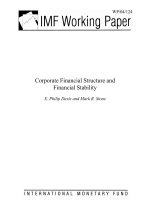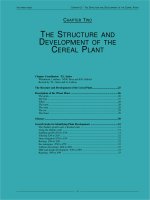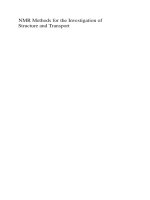banking industry structure and competition
Bạn đang xem bản rút gọn của tài liệu. Xem và tải ngay bản đầy đủ của tài liệu tại đây (437.44 KB, 26 trang )
Copyright 2011
Pearson Canada Inc.
11-
1
Chapter 11
Banking Industry:
Structure and Competition
Copyright 2011
Pearson Canada Inc.
11-
2
Historical Development of the Canadian
Banking System I
Copyright 2011
Pearson Canada Inc.
11-
3
Historical Development of the Canadian
Banking System II
•
The Free Banking Experiment
•
The Provincial Notes Act, 1866
•
The Dominion Notes Act, 1870
–
Seignorage
–
Gold standard
•
The First Bank Act, 1871
•
The Bank Act, 1881-1913
•
The Finance Act, 1914
–
Lender of last resort
Copyright 2011
Pearson Canada Inc.
11-
4
Financial Innovation and the Growth of
the Shadow Banking System
•
Shadow banking system – bank lending
replaced by lending via securities markets
•
A change in the financial environment will
stimulate a search by financial institutions for
innovations that are likely to be profitable
–
Responses to change in demand conditions
–
Responses to changes in supply conditions
–
Avoidance of regulations
Copyright 2011
Pearson Canada Inc.
11-
5
Responses to Changes in Demand Conditions:
Interest Rate Volatility
•
Adjustable-rate mortgages
–
Flexible interest rates keep profits high when rates
rise
–
Lower initial interest rates make them attractive to
home buyers
•
Financial Derivatives
–
Ability to hedge interest rate risk using futures
contracts (financial derivatives)
–
Payoffs are linked to previously
issued securities
Copyright 2011
Pearson Canada Inc.
11-
6
Responses to Changes in Supply Conditions:
Information Technology
•
Bank credit and debit cards
–
Improved computer technology lowers transaction costs
•
Electronic banking
–
ATM
–
Home banking
–
ABM
–
Virtual banking
•
Junk bonds
•
Commercial paper market
•
Securitization
Copyright 2011
Pearson Canada Inc.
11-
7
Avoidance of Existing Regulations
•
Reserve requirements act as a tax
on deposits
•
Restrictions on interest paid on deposits led to
disintermediation
–
Money market mutual funds
–
Sweep accounts
Copyright 2011
Pearson Canada Inc.
11-
8
Financial Innovation and the Decline
of Traditional Banking
•
Decline in Cost advantage of Acquiring Funds
(Liabilities)
–
Disintermediation
•
Decline in Income Advantage on uses of funds (Assets)
•
Bank Responses
- No decline in overall profitability
- Increase in income from off-balance sheet activities
•
Decline of Traditional Banking in Other Industrialized
Countries
Copyright 2011
Pearson Canada Inc.
11-
9
•
The Big Six, together with the Laurentian Bank of
Canada, the Canadian Western Bank, and
another 8 domestic banks are Canada’s Schedule
I banks
•
Until 1981, foreign banks were not allowed to
operate in Canada
•
Schedule II banks are some domestic banks
controlled by eligible foreign institutions
•
A Schedule III bank is a foreign bank branches of
foreign institutions
Schedule I, II and III Banks
Copyright 2011
Pearson Canada Inc.
11-
10
Canadian Banks
Copyright 2011
Pearson Canada Inc.
11-
11
Competition and Technology
•
Besides chartered banks, there are over 4000 financial
institutions providing services, these include trust,
mortgage loan companies, credit unions, caisses
populaires, government saving institutions, insurance
companies, pension funds, mutual funds and
investment dealers
•
New technology and the internet have led to more
competition and innovative banking in Canada
•
2001 changes in bank ownership laws have
encouraged the establishment of new banks
Copyright 2011
Pearson Canada Inc.
11-
12
•
73 chartered banks in Canada and around 7,100 in the
United States
•
The presence of so many banks in the U.S. reflects past
regulations that restricted the ability of these financial
institutions to open branches
•
Many small U.S. banks stayed in existence because a
large bank capable of driving them out of business was
often restricted from opening a branch nearby
•
It was easier for a bank to open a branch in a foreign
country than in another state in the U.S.
Comparison with the United States
Copyright 2011
Pearson Canada Inc.
11-
13
Comparison with the United States
Copyright 2011
Pearson Canada Inc.
11-
14
Response to Branching Restrictions in the U.S.
Response to Branching Restrictions
1. Bank Holding Companies
-corporation that owns several different
companies
2. Automated Teller Machines
-if owned by someone else, ATM not
considered a branch and not subject to
branching regulations
Copyright 2011
Pearson Canada Inc.
11-
15
Competition Across All Four Pillars and
Convergence
•
In the past, Canada’s financial services industry was
regulated by institution (banks, securities,
insurance, and real estate). This approach to
regulation has been known as the four-pillar
approach
•
Recent legislative changes allowed cross-ownership
via subsidiaries between financial institutions
•
As a result, Canada’s traditional four pillars have
now converged into a single financial services
marketplace
Copyright 2011
Pearson Canada Inc.
11-
16
Implications for Financial Consolidation
1. The way is now open to consolidation in terms not
only of the number of banking institutions, but also
across financial service activities
2. Banking institutions will become not only larger, but
increasingly complex organizations, engaging in the
full gamut of financial service activities taking
advantage of economies of scale and economies of
scope
3. Mega-mergers like that of Citicorp and Travelers in
the U.S. should become increasingly common
Copyright 2011
Pearson Canada Inc.
11-
17
Separation of Banking and Other Financial
Services Industries Throughout the World
1. Universal banking
- No separation between banking and
securities industries
2. British-style universal banking
- May engage in security underwriting
3. Japanese Model
- Some legal separation of banking and other
financial services
Copyright 2011
Pearson Canada Inc.
11-
18
The Near Banks: Regulation and Structure
Trust Companies and Mortgage Loan Companies:
•
Operate under a charter issued by either the
federal government or one of the provinces
•
Federally incorporated TMLs are regulated and
supervised by the OSFI and must also register in
all provinces in which they operate and conform
to their regulations
•
The fiduciary component of trust companies is
only subject to provincial legislation, even if the
company is federally incorporated
•
CDIC and QDIB (for Québec TMLs)
Copyright 2011
Pearson Canada Inc.
11-
19
Credit Unions and Caisses Populaires
•
Established under provincial legislation
•
Are non-profit seeking institutions
•
Accept deposits and make loans only to members
•
Members have voting rights, elect board of
directors, which determine lending and investment
policies
•
Have their own set of institutions, including central
banking and deposit insurance
•
The main source of funds is deposits (85% of
liabilities) followed by members equity (7%)
•
Asset portfolio made up largely of mortgages (55%)
Copyright 2011
Pearson Canada Inc.
11-
20
Government Savings Institutions
Province of Ontario Savings Office
•
Established in 1921
•
Today only lends to the Treasurer of Ontario for
provincial government purposes
Alberta Treasury Branches
•
Established in 1938
•
Today there are 150 branches and 225 ATMs in 242
communities across Alberta, operating in three target
markets: individual financial services, agricultural
operations, and independent business
Copyright 2011
Pearson Canada Inc.
11-
21
International Banking
•
Rapid growth
–
Growth in international trade and multinational
corporations
–
Global investment banking is very profitable
–
Ability to tap into the Eurodollar market
Copyright 2011
Pearson Canada Inc.
11-
22
Eurocurrencies Market
•
Mostly dollar-denominated deposits held in
banks outside of the U.S.
•
Most widely used currency in international
trade
•
Offshore deposits not subject to regulations
Copyright 2011
Pearson Canada Inc.
11-
23
Canadian Banking Overseas
Copyright 2011
Pearson Canada Inc.
11-
24
Foreign Banks in Canada I
•
Bank Act 1981 allowed foreign banks to
operate in Canada
•
Currently hold about 8% of total Canadian bank
assets
–
HSBC Bank Canada (national market share of 3%)
•
Foreign banks enter financial services industry
as Schedule II or Schedule III banks
Copyright 2011
Pearson Canada Inc.
11-
25
Foreign Banks in Canada II









